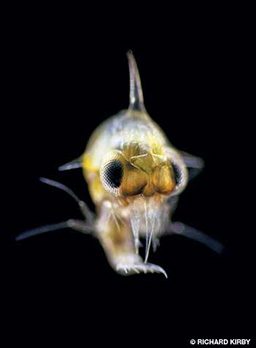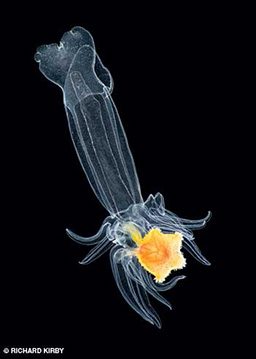
For hours to months at a time, larvae drift across the seas. They are diminutive, alienlike creatures typically less than a millimeter across, often looking very unlike their adult counterparts. In time and with change they become more familiar in shape and size, but initially the ocean’s youngest life-forms can be a mysterious and odd-looking lot.
The paper-thin phyllosoma is a flat, white skeleton of a creature that more resembles a tiny Halloween decoration or a squashed spider than a prized delicacy — the spiny lobster. Another larva, the zoea, is a miniature bug-eyed Pac-Man sporting a pith helmet, a far cry from the clawed crab it’s destined to become. Larval sea stars are tricky characters as well. With a transparent blob of a body and what seem to be too many arms, this young echinoderm appears to be mimicking an early-stage squid or octopus.
Tiny jellyfish, baby squid, eels and larval fishes look more like their grown-up forms, but distinguishing species early in their development can be almost impossible. Many organisms in the ocean, particularly bottom-dwelling invertebrates, have complex life cycles that include large-scale deployment of drifting, nearly unrecognizable young that transform into adults through a series of dramatic metamorphoses.
Reproductive Strategies
Over time, several common strategies for bringing forth new generations in the ocean have evolved. The goal of them all, of course, is to promote the survival of offspring. Some marine organisms give birth to what are essentially miniature versions of themselves; these young are ready to crawl, swim or even hunt on day one. For example, the young sand tiger shark is one baby not to be messed with — even in the womb. Sand tiger shark embryos hatch in utero. The largest tends to hatch first. Already teethed and hungry, the young pup preys on its developing siblings. One could say that sand tiger sharks are the ultimate natural-born killers, having had hunting experience even before birth. This is an extreme example of what is called a brooding approach to reproduction, in which only a few, well-developed young are produced.
A more common strategy is to produce an abundance of less-developed offspring and broadcast them. In broadcasting, large numbers of eggs or larvae are released into the water and become diminutive members of the wandering, drifting crowd we call plankton.
Advantages of Being a Drifter

Why release thousands to millions of eggs or larvae into the sea, leaving their travels at the mercy of the wind, waves and currents? This reproductive strategy allows widespread dispersal, which can prevent overcrowding back at the parental home and provide the young with access to new geographic areas or habitats. In addition, drifting larvae do not have to compete with adults for food, and genes are exchanged over a wider range. By releasing an abundance of young, organisms hedge their bets.
Larvae make for easy meals, especially for relatively small predators. But even large-mouthed feeders enjoy an egg or larva feast. During mass spawning events on reefs, in which corals synchronize the release of eggs and sperm, the nighttime buffet attracts a wide variety of diners. Worms fill the water, fish swarm, and even whale sharks swoop in to consume huge quantities of eggs and developing larvae in mouthful after giant mouthful. But it’s not just predators that spell doom for the wandering young. Unfavorable currents, a lack of food or harmful conditions may all end a young life. By releasing copious quantities of larvae, chances are that a few will survive.
Odd Forms
Planktonic larvae often look very different from their fully grown versions because of larvae’s need to stay adrift and avoid predators. Most larvae are either transparent or translucent, which helps them go unseen in the ocean’s sunlit layers. The sharp spine on the crab zoea is a means to deter some small predators. It also increases the surface area of the organism, thus helping it stay aloft in the water column.
Spines, spikes, pits, flaps, feathery cilia and a flat shape all increase an organism’s surface area and improve floatation. Baby snails, which resemble miniature, flying versions of the adults, have a winglike sheet of tissue that keeps them adrift. Larvae additionally need a means to detect and capture organic particles for food; although larvae are not considered true swimmers, many are weakly motile for this purpose.
The Metamorphosis
The larvae that successfully run the ocean’s gauntlet morph into juveniles and eventually adults. They may become full-fledged swimmers or sink to the bottom to live on (and perhaps attached to) the seafloor. Just finding the right spot to homestead can be problematic. Some benthic invertebrates, such as barnacles and oysters, are considered gregarious settlers — they need to settle in previously established communities of their own kind. Other organisms need a specific type of substrate or chemical cue or have to avoid others of their own kind due to cannibalistic appetites. When, where and how organisms transition from larvae to juvenile to adult varies. In some cases it is just a matter of increasing in size, but in others it is an extreme life change where little, if any, resemblance to the larval form remains.

Larval fish frequently look similar to their adult forms. One type of fish, however, shows a surprising dissimilarity. The larval flatfish appears very fishlike, with a typical body shape and tail and an eye on either side of its head. An adult flatfish, such as a flounder, sole or halibut, however, has both eyes on the top of its body (or is it the side?). During the transition from larva to adult, these fish have a truly awkward adolescent stage in which one of the eyes moves over the top of the head to the other side. The fish then lies down on the bottom on its eyeless side. Some species of flatfish are right-side blind, while others are left-side blind; it depends on which eye did the traveling.
In many benthic invertebrates the metamorphosis from floating larva to bottom dweller includes a series of morphological and biochemical changes. The most dramatic changes may take place while drifting, or they may occur once the organism settles on the bottom. In corals, much of this transformation takes place on the seafloor. Once a suitable landing site is detected (often with chemical cues), the coral larva swims down. In some species of coral, the presence of crustose coralline algae provides the chemical signal required.
Coral larvae in contact with a suitable bottom first contract and then lay down an organic matrix that’s followed by the beginnings of their stony calcium-carbonate skeletons. The metamorphosis continues as the coral develops its first skeletal cup and a mouth surrounded by a ring of tentacles containing nematocysts (stinging cells). For coral larvae that are the result of broadcast spawning, at this stage they take on their algal partners, the symbiotic zooxanthellae that live within their tissues. The budding of clones from the initial coral-polyp settler generates a growing coral colony. If a substrate is not suitable, coral larvae sometimes get a second chance — a free-floating reprieve — by contracting, detaching and returning to the life of a drifter in search of a good home.

For echinoderms such as sea urchins, brittlestars, sea cucumbers and sea stars, the metamorphosis from larva to familiar-looking juvenile takes place both in the water column and on the bottom. Sea stars, for example, may transform from barrel-shaped blobs to armed octopus mimics while adrift in the water and then attach to the seafloor and morph again. Eventually a crawling, free-living sea star comes into being.
Jellyfish also have a two-act life cycle. Drifting jellyfish larvae settle on the seafloor whereupon they morph into flowerlike polyp structures that bud asexually — like mother ships releasing tiny flying saucers from a stack, one after another. These are the baby jellies that drift and develop into the familiar bell form.
One of the most significant transformations takes place in tunicates (sea squirts). As adults these typically look like colorful clusters of tiny tubes attached to the bottom. However, sea-squirt larvae resemble tadpoles — complete with tails and notochords. Once a suitable attachment site is found, the tadpolelike larva attaches to the seafloor by its head, the tail degenerates, and it proceeds to change into the adult sea-squirt form.
A crab undergoes the transition from cute, Pac-Man zoea to crawling and clawed adult in numerous stages. In crustaceans, molting plays an important role early in and throughout their lives. With a hard exoskeleton or carapace, crustaceans must molt their shells to make way for bigger bodies. In addition, these animals must be appropriately outfitted for a life afloat in the early days of their existence, hence their adornment with spines and feathery cilia.
In the ocean’s planktonic young, change is often dramatic, illustrating the complexity and diversity of life in the sea. The variations on the theme are many, but the overall goal is the same: to survive.
© Alert Diver — Q2 Spring 2013